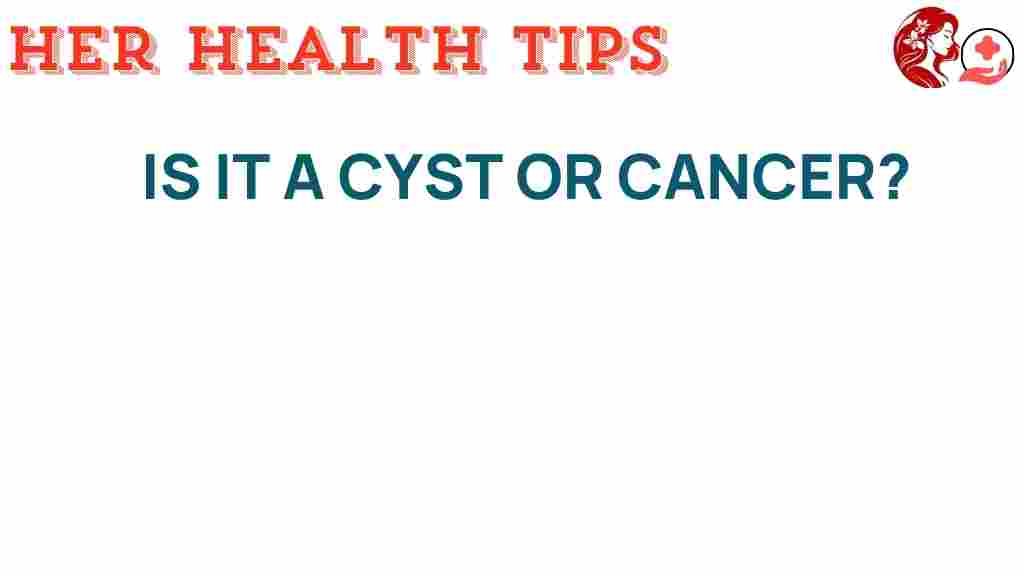Unraveling the Mystery: Is it a Cyst or Cancer?
The distinction between a cyst and cancer is a topic of significant concern for many individuals. Understanding the differences can lead to better health outcomes and informed decision-making. This article will delve into the specifics of cysts and cancer, focusing on diagnosis, symptoms, medical imaging, treatment options, and the importance of awareness in patient care.
Understanding Cysts and Cancer
Cysts are usually benign, fluid-filled sacs that can develop in various parts of the body, while cancer refers to a group of diseases characterized by the uncontrolled growth of abnormal cells. The confusion between these two conditions often arises due to overlapping symptoms and the necessity for medical imaging to reach an accurate diagnosis.
Key Differences Between Cysts and Cancer
- Nature: Cysts are typically non-cancerous, while cancer is characterized by malignant growth.
- Growth Rate: Cysts tend to grow slowly, whereas cancerous tumors can grow rapidly.
- Pain and Symptoms: Cysts may be painless, while cancer can cause significant discomfort and other symptoms.
Symptoms: How to Tell if it’s a Cyst or Cancer
Recognizing the symptoms associated with cysts and cancer is crucial for early diagnosis and treatment. Here are common symptoms for both:
Common Symptoms of Cysts
- Swelling in the affected area
- Pain or discomfort if the cyst presses against nerves or tissues
- Fluid-filled lumps that may be visible under the skin
- Occasional redness or warmth around the cyst
Common Symptoms of Cancer
- Unexplained weight loss
- Persistent pain in a specific area
- Fatigue that doesn’t improve with rest
- Changes in the skin, such as new moles or changes in existing ones
- Unusual bleeding or discharge
Diagnosis: How are Cysts and Cancer Diagnosed?
The diagnostic process is essential for determining whether a growth is a cyst or cancer. Here’s a step-by-step breakdown of the process:
Step 1: Medical History and Physical Examination
Your doctor will start by taking a comprehensive medical history and performing a physical examination. They will ask about your symptoms, family history, and any previous medical conditions.
Step 2: Medical Imaging
Once the initial evaluation is complete, medical imaging may be used for further diagnosis. Common imaging techniques include:
- X-rays: Useful for detecting bone abnormalities.
- Ultrasound: Helps visualize soft tissues and fluid-filled cysts.
- CT scans: Provides detailed cross-sectional images of the body.
- MRI: Offers high-resolution images of soft tissues, making it particularly useful for brain and spinal assessments.
Step 3: Laboratory Tests
If imaging suggests the possibility of cancer, your doctor may recommend a biopsy. This procedure involves taking a small sample of tissue for laboratory analysis. Lab tests can help determine whether the cells are benign or malignant.
Treatment Options: Addressing Cysts and Cancer
Both cysts and cancer require different treatment approaches:
Treatment for Cysts
- Observation: Many cysts do not require treatment and can be monitored over time.
- Drainage: If a cyst is painful or infected, your doctor may recommend draining it.
- Surgery: In some cases, surgical removal of the cyst may be necessary, especially if it recurs or causes discomfort.
Treatment for Cancer
- Surgery: Often the primary treatment for removing tumors.
- Radiation Therapy: Uses high-energy rays to kill cancer cells.
- Chemotherapy: Involves the use of drugs to target and kill cancer cells.
- Immunotherapy: Stimulates the body’s immune system to fight cancer.
The Importance of Awareness in Patient Care
Understanding the differences between cysts and cancer is vital for effective patient care. Awareness can lead to early detection and treatment, which significantly improves health outcomes. Here are some tips for maintaining awareness:
- Regularly perform self-examinations to detect any changes in your body.
- Stay informed about your family history of health conditions.
- Consult a healthcare professional if you notice any unusual symptoms.
- Participate in health screenings recommended for your age and risk factors.
Troubleshooting Tips for Patients
If you are experiencing symptoms that may indicate a cyst or cancer, consider these troubleshooting tips:
- Keep a Symptom Diary: Documenting your symptoms can help your doctor understand your condition better.
- Seek Second Opinions: If you’re unsure about your diagnosis, don’t hesitate to get a second opinion from another healthcare provider.
- Educate Yourself: Use reputable sources to learn more about cysts and cancer.
- Follow Up: Ensure you attend all follow-up appointments and screenings as advised by your healthcare provider.
For more information on cysts and cancer, consider visiting Cancer.gov for comprehensive resources and support.
Conclusion
In conclusion, understanding the differences between cysts and cancer is crucial for early diagnosis and effective treatment. By being aware of the symptoms, undergoing appropriate medical imaging, and seeking timely medical advice, individuals can navigate their health concerns more effectively. Remember, knowledge is power when it comes to your health, and taking proactive steps can lead to better outcomes.
For continuous support and information on health and wellness, feel free to explore our other articles on health awareness.
This article is in the category Conditions and created by HerHealthTips Team
